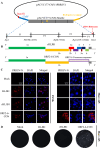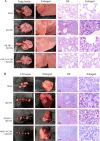A chimeric porcine reproductive and respiratory syndrome virus 1 strain containing synthetic ORF2-6 genes can trigger T follicular helper cell and heterologous neutralizing antibody responses and confer enhanced cross-protection
- PMID: 38449049
- PMCID: PMC10918997
- DOI: 10.1186/s13567-024-01280-3
A chimeric porcine reproductive and respiratory syndrome virus 1 strain containing synthetic ORF2-6 genes can trigger T follicular helper cell and heterologous neutralizing antibody responses and confer enhanced cross-protection
Abstract
The prevalence of porcine reproductive and respiratory syndrome virus 1 (PRRSV1) isolates has continued to increase in Chinese swine herds in recent years. However, no effective control strategy is available for PRRSV1 infection in China. In this study, we generated the first infectious cDNA clone (rHLJB1) of a Chinese PRRSV1 isolate and subsequently used it as a backbone to construct an ORF2-6 chimeric virus (ORF2-6-CON). This virus contained a synthesized consensus sequence of the PRRSV1 ORF2-6 gene encoding all the envelope proteins. The ORF2-6 consensus sequence shared > 90% nucleotide similarity with four representative strains (Amervac, BJEU06-1, HKEU16 and NMEU09-1) of PRRSV1 in China. ORF2-6-CON had replication efficacy similar to that of the backbone rHLJB1 virus in primary alveolar macrophages (PAMs) and exhibited cell tropism in Marc-145 cells. Piglet inoculation and challenge studies indicated that ORF2-6-CON is not pathogenic to piglets and can induce enhanced cross-protection against a heterologous SD1291 isolate. Notably, ORF2-6-CON inoculation induced higher levels of heterologous neutralizing antibodies (nAbs) against SD1291 than rHLJB1 inoculation, which was concurrent with a higher percentage of T follicular helper (Tfh) cells in tracheobronchial lymph nodes (TBLNs), providing the first clue that porcine Tfh cells are correlated with heterologous PRRSV nAb responses. The number of SD1291-strain-specific IFNγ-secreting cells was similar in ORF2-6-CON-inoculated and rHLJB1-inoculated pigs. Overall, our findings support that the Marc-145-adapted ORF2-6-CON can trigger Tfh cell and heterologous nAb responses to confer improved cross-protection and may serve as a candidate strain for the development of a cross-protective PRRSV1 vaccine.
Keywords: IFNγ-secreting cells; ORF2-6 chimeric virus; T follicular helper (Tfh) cells; cross-protection; neutralizing antibodies (nAbs); porcine reproductive and respiratory syndrome virus 1 (PRRSV1).
© 2024. The Author(s).
Conflict of interest statement
The authors declare that they have no competing interests.
Figures





Similar articles
-
Chimeric HP-PRRSV2 containing an ORF2-6 consensus sequence induces antibodies with broadly neutralizing activity and confers cross protection against virulent NADC30-like isolate.Vet Res. 2021 May 27;52(1):74. doi: 10.1186/s13567-021-00944-8. Vet Res. 2021. PMID: 34044890 Free PMC article.
-
Minor and major envelope proteins of PRRSV play synergistic roles in inducing heterologous neutralizing antibodies and conferring cross protection.Virus Res. 2022 Jul 2;315:198789. doi: 10.1016/j.virusres.2022.198789. Epub 2022 Apr 26. Virus Res. 2022. PMID: 35487365
-
Metagenomic and Pathogenic Assessments Identify a Pathogenic Porcine Reproductive and Respiratory Syndrome Virus 1 with New Deletions from Adult Slaughter Pig in 2022.Transbound Emerg Dis. 2023 Apr 13;2023:1975039. doi: 10.1155/2023/1975039. eCollection 2023. Transbound Emerg Dis. 2023. PMID: 40303817 Free PMC article.
-
Efficacy of a porcine reproductive and respiratory syndrome virus 1 (PRRSV-1) natural recombinant against a heterologous PRRSV-1 isolate both clustered within the subgroup of BJEU06-1-like isolates.Vet Microbiol. 2023 Oct;285:109847. doi: 10.1016/j.vetmic.2023.109847. Epub 2023 Aug 12. Vet Microbiol. 2023. PMID: 37625255
-
Live porcine reproductive and respiratory syndrome virus vaccines: Current status and future direction.Vaccine. 2015 Aug 7;33(33):4069-80. doi: 10.1016/j.vaccine.2015.06.092. Epub 2015 Jul 4. Vaccine. 2015. PMID: 26148878 Review.
Cited by
-
Isolation and Genomic Characterization of a Novel Porcine Reproductive and Respiratory Syndrome Virus 1 from Severely Diseased Piglets in China in 2024.Vet Sci. 2025 Jan 15;12(1):61. doi: 10.3390/vetsci12010061. Vet Sci. 2025. PMID: 39852936 Free PMC article.
-
Propidium Monoazide Integrated With qPCR Enables Rapid and Universal Detection of Infectious Porcine Reproductive and Respiratory Syndrome Viruses.Transbound Emerg Dis. 2024 Dec 21;2024:6250851. doi: 10.1155/tbed/6250851. eCollection 2024. Transbound Emerg Dis. 2024. PMID: 40303043 Free PMC article.
-
The GP2a 91/97/98 amino acid substitutions play critical roles in determining PRRSV tropism and infectivity but do not affect immune responses.J Virol. 2025 Apr 15;99(4):e0004825. doi: 10.1128/jvi.00048-25. Epub 2025 Mar 12. J Virol. 2025. PMID: 40071920 Free PMC article.
-
A centralised immunogen approach to develop a more broadly protective modified live porcine reproductive and respiratory syndrome virus 1 vaccine candidate.NPJ Vaccines. 2025 Jun 21;10(1):129. doi: 10.1038/s41541-025-01192-z. NPJ Vaccines. 2025. PMID: 40544181 Free PMC article.
-
Ten years after introduction of NADC30-like strain in China: a novel chimeric porcine reproductive and respiratory syndrome vaccine candidate.Front Immunol. 2025 May 8;16:1585197. doi: 10.3389/fimmu.2025.1585197. eCollection 2025. Front Immunol. 2025. PMID: 40406142 Free PMC article.
References
-
- Walker PJ, Siddell SG, Lefkowitz EJ, Mushegian AR, Adriaenssens EM, Dempsey DM, Dutilh BE, Harrach B, Harrison RL, Hendrickson RC, Junglen S, Knowles NJ, Kropinski AM, Krupovic M, Kuhn JH, Nibert M, Orton RJ, Rubino L, Sabanadzovic S, Simmonds P, Smith DB, Varsani A, Zerbini FM, Davison AJ. Changes to virus taxonomy and the statutes ratified by the international committee on taxonomy of viruses (2020) Arch Virol. 2020;165:2737–48. doi: 10.1007/s00705-020-04752-x. - DOI - PubMed
-
- Wensvoort G, Terpstra C, Pol JM, ter Laak EA, Bloemraad M, de Kluyver EP, Kragten C, van Buiten L, den Besten A, Wagenaar F, Broekhuijsen JM, Moonen PLJM, Zetstra T, de Boer EA, Tibben HJ, de Jong MF, van't Veld P, Greenland GJR, van Gennep JA, Voets MTh, Verheijden JHM, Braamskamp J, Mystery swine disease in the Netherlands: the isolation of Lelystad virus. Vet Q. 1991;13:121–30. doi: 10.1080/01652176.1991.9694296. - DOI - PubMed
MeSH terms
Substances
Grants and funding
- 31802172/National Natural Science Foundation of China
- BK202111603/Natural Science Foundation for Excellent Young Scholars of Jiangsu Province
- GTKF(23)006/Open Project Program of National Research Center of Veterinary biological products and Engineering technology
- No. 3/Open Project Program of International Research Laboratory of Prevention and Control of Important Animal Infectious Diseases and Zoonotic Diseases of Jiangsu Higher Education Institutions
- KLAPII202202/Open Project Program of Key Laboratory of animal pathogen infection and Immunology of Fujian Province
LinkOut - more resources
Full Text Sources

